Vatnajökull National Park is one of the three national parks in Iceland, a land built by volcanoes and sculpted by ice. Vatnajökull National Park is the second largest national park in Europe after merging two national parks in 2008: Jökulsárgljúfur National Park and Skaftafell National Park. Jökulsárgljúfur is the northernmost part of Vatnajökull National Park, situated in the northern part of Iceland. Skaftafell is situated in the southeastern part of Iceland. The two national parks have separate boundaries but are connected by the glacial river Jökulsá á Fjöllum, the river is fed by the meltwater of the ice and snow from the Vatnajökull, the largest glacier of Iceland. The Dettifoss is the most impressive waterfall in the river Jökulsá á Fjöllum, the Dettifoss is the most powerful waterfall in Europe, the Dettifoss is situated in Jökulsárgljúfur National Park. The impressive Vatnajökull glacier is situated in Skaftafell National Park, a popular tourist attraction. Another popular attraction in Skaftafell is the Svartifoss, a waterfall surrounded by hexagonal basalt columns, similar lava formations exist also at the Giant's Causeway in Northern Ireland. Another popular tourist attractions on Iceland is Jökulsárlón, the largest glacial lake in Iceland, the lake is situated close to Skaftafell National Park. Vatnajökull National Park - dynamic nature of fire and ice - gained the status as a UNESCO World Heritage in 2019. Vatnajökull National Park is a natural World Heritage Site.
www.werelderfgoedfotos.nl © Copyright World Heritage Photos
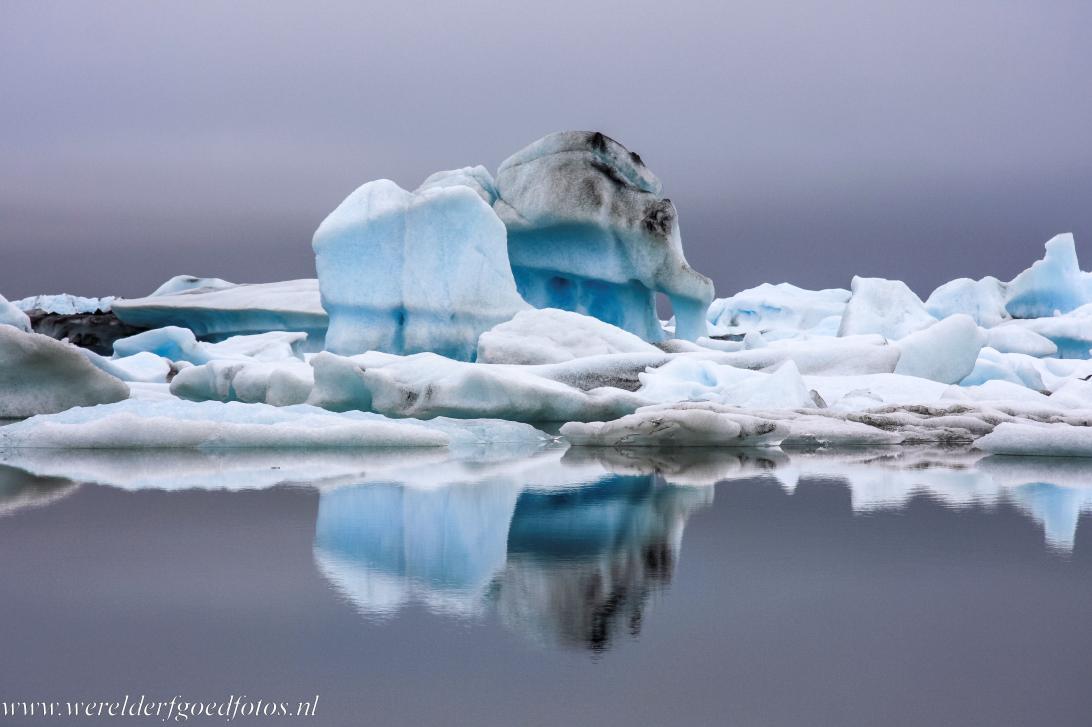
Vatnajökull National Park - dynamic nature of fire and ice: Jökulsárlón is the largest glacial lake on Iceland. The glacial water of Jökulsárlón is dotted with numerous icebergs that break away from the Breiðamerkurjökull glacier tongue, the primary inflow of Jökulsárlón. The impressive icebergs range in size and colours, the nature is the sculptor of these frozen wonders of Iceland.

Vatnajökull National Park - dynamic nature of fire and ice: Jökulsárlón is the largest glacial lake on Iceland. The glacial water of Jökulsárlón is dotted with numerous icebergs that break away from the Breiðamerkurjökull glacier tongue, the primary inflow of Jökulsárlón. The impressive icebergs range in size and colours, the nature is the sculptor of these frozen wonders of Iceland.
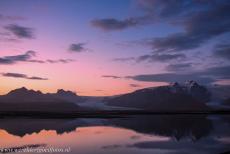
Vatnajökull National Park - dynamic nature of fire and ice: The evening sky at twilight reflected in the glacial lake Breiðarlón. In the background the Breiðamerkurjökull, one of the largest glacier tongues of the Vatnajökull glacier. From the glacial lake Breiðarlón a small stream flows into the Fjallsárlón glacial lake. The glacial lake Breiðarlón is situated at the south end of the Vatnajökull.
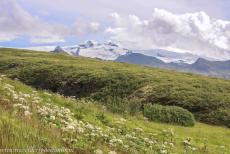
Vatnajökull National Park - dynamic nature of fire and ice: The Hvannadalshnúkur is a peak on the rim of the summit of the Öræfajökull vulcano. The Hvannadalshnúkur is the highest peak in Iceland, the mountain is 2,109.6 metres high, it can be viewed from many parts of Iceland. The climb to the top takes 12 to 15 hours and is only safe with experienced mountain guides.
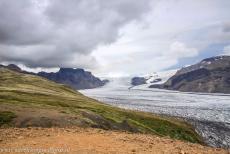
Vatnajökull National Park - dynamic nature of fire and ice: The Skaftafellsjökull, a glacier tongue of the Vatnajökull, the largest glacier of Iceland. The thickest part of the ice cap of the glacier is almost a whole kilometre, the average thickness is about 500 metres. The Vatnajökull glacier has around thirty glaciers tongues. The glaciers tongues often ends in a glacier lake.
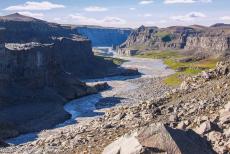
The glacial river Jökulsá á Fjöllum flowing through the magnificent Jökulsárgljúfur canyon. The Jökulsárgljúfur canyon is situated in Jökulsárgljúfur National Park, the northernmost part of the Vatnajökull National Park. The two national parks have separate boundaries but are connected by the river Jökulsá á Fjöllum. The river originates from the melt water of the Vatnajökull glacier.
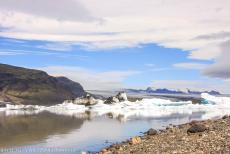
Vatnajökull National Park - dynamic nature of fire and ice: The Fjallsjökull glacier and Fjallsárlón glacial lake, the water of the lake is dotted with icebergs from the glacier. The Fjallsjökull is one of the many glacier tongues of the Vatnajökull glacier. The Fjallsárlón is a much smaller glacial lake than the more famous Jökulsárlón glacial lake.
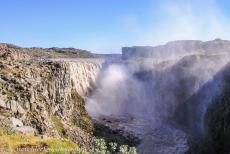
The Dettifoss is situated in the Jökulsárgljúfur National Park, a part of Vatnajökull National Park. The Dettifoss is a waterfall in the Jökulsá á Fjöllum, a river flowing through the largest and most impressive canyon on Iceland, the Jökulsárgljúfur. This canyon is also notable for its waterfalls, the Hafragilsfoss, Réttarfoss, Sellfoss and Dettifoss, the most powerful waterfall in Europe.
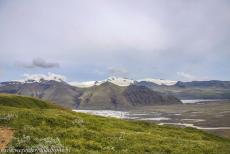
Vatnajökull National Park - dynamic nature of fire and ice: The Hvannadalshnúkur Mountain and the Öræfajökull on the Vatnajökull Glacier. The Öræfajökull is an ice-covered volcano, the largest active volcano and probably the most violent volcano on Iceland. The huge Hvannadalshnúkur is the most famous peak of the Öræfajökull, the mountain is covered in ice throughout the year.
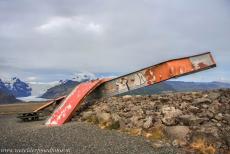
Vatnajökull National Park - dynamic nature of fire and ice: The Skeiðará Bridge Monument, in the background the Skeiðarárjökull, a glacier tongue of the Vatnajökull. The Skeiðará Bridge was once the longest bridge span in Iceland. In 1996, the bridge was destroyed by an eruption of the Grímsvötn volcano and glacial floods. Twisted girders are all that remain of the Skeiðará Bridge.
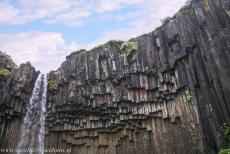
Vatnajökull National Park - dynamic nature of fire and ice: The Svartifoss, a waterfall surrounded by dark hexagonal basalt columns. The basalt columns inspired the Icelandic architect Guðjón Samúelsson when he designed the Hallgrímskirkja, a famous church in Reykjavik and the tallest church of Iceland. The 20 metres high Svartifoss is located in Skaftafell National Park.
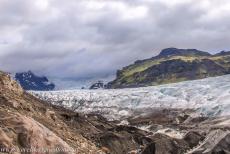
Vatnajökull National Park - dynamic nature of fire and ice: The Svinafellsjökull is a glacier tongue of the Vatnajökull, the largest ice cap in Europe. The Svinafellsjökull was one of the film locations in Iceland for the epic TV series Game of Thrones, the glacier was used to represent the snowy landscapes of 'Beyond the Wall'. The Svinafellsjökull is nicknamed 'Hollywood Glacier' because many films and TV series have been filmed here, such as James Bond and Batman.
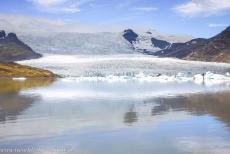
Vatnajökull National Park - dynamic nature of fire and ice: The head of the Breiðamerkurjökull glacier and Breiðarlón glacial lake. The Breiðamerkurjökull is a glacier tongue of the Vatnajökull glacier. The Breiðamerkurjökull is constantly melting and retreating, large blocks of ice break off the edge of the glacier, fall into the water and float from the glacier lake towards the ocean.
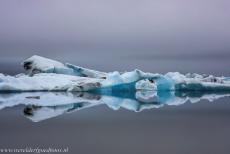
Vatnajökull National Park - dynamic nature of fire and ice: Amazing blue and white icebergs and their reflections on Jökulsárlón. The glacial lake of Jökulsárlón is connected to the North Atlantic Ocean by the Jökulsá, the shortest river in Iceland. The Jökulsá carries the icebergs towards the ocean where they break apart and slowly melt.

Vatnajökull National Park - dynamic nature of fire and ice: Blue and white icebergs float slowly from Jökulsárlón towards the North Atlantic Ocean, before they reach the ocean, they often wash ashore at Breiðamerkursandur, a black sand beach, also known as Diamond Beach. The black sand beaches in Iceland are the result of volcanic activity.
